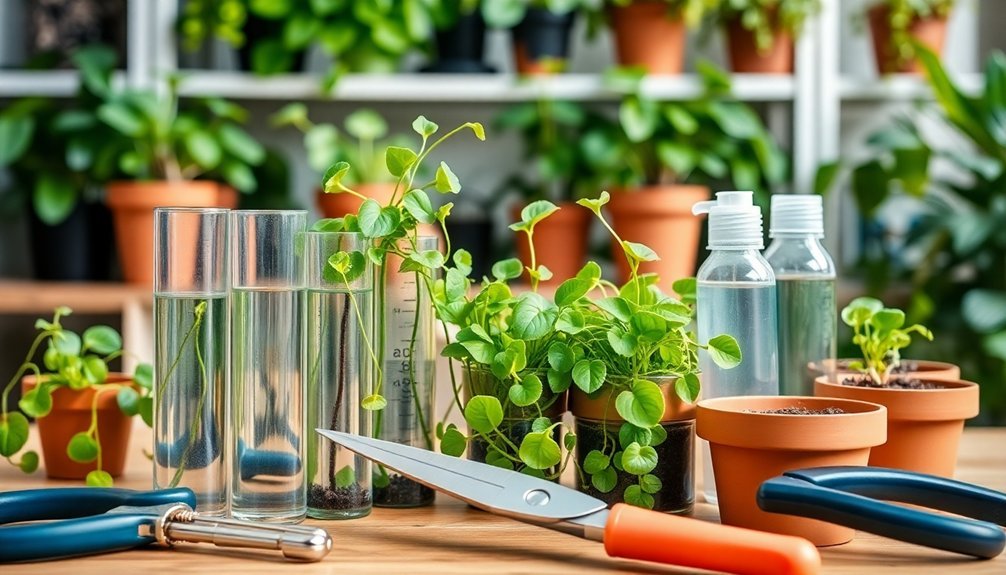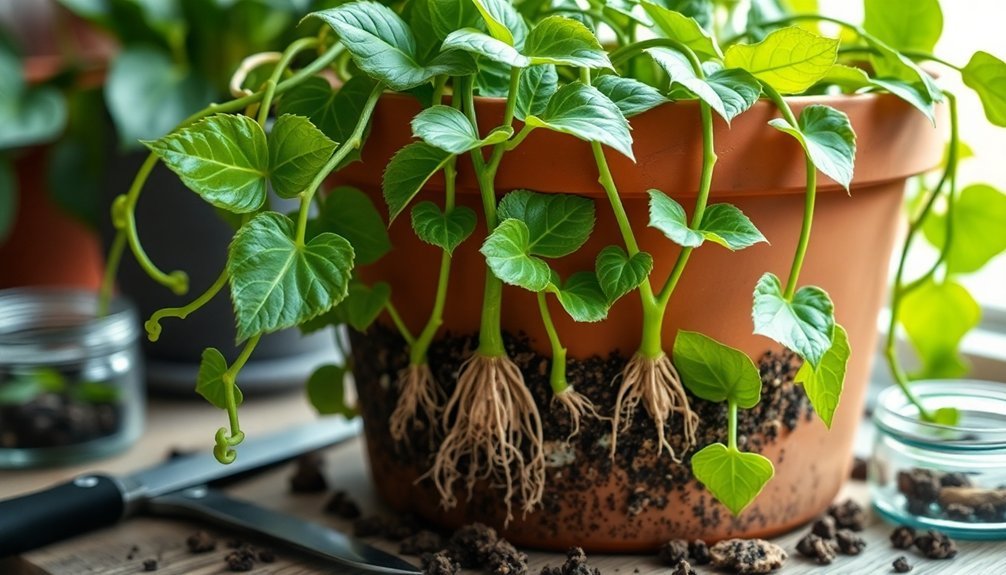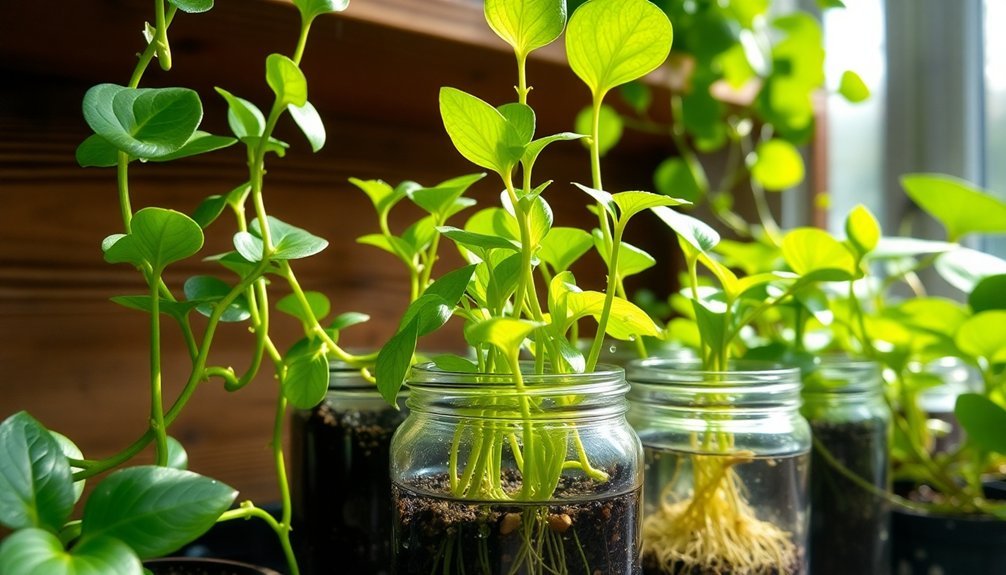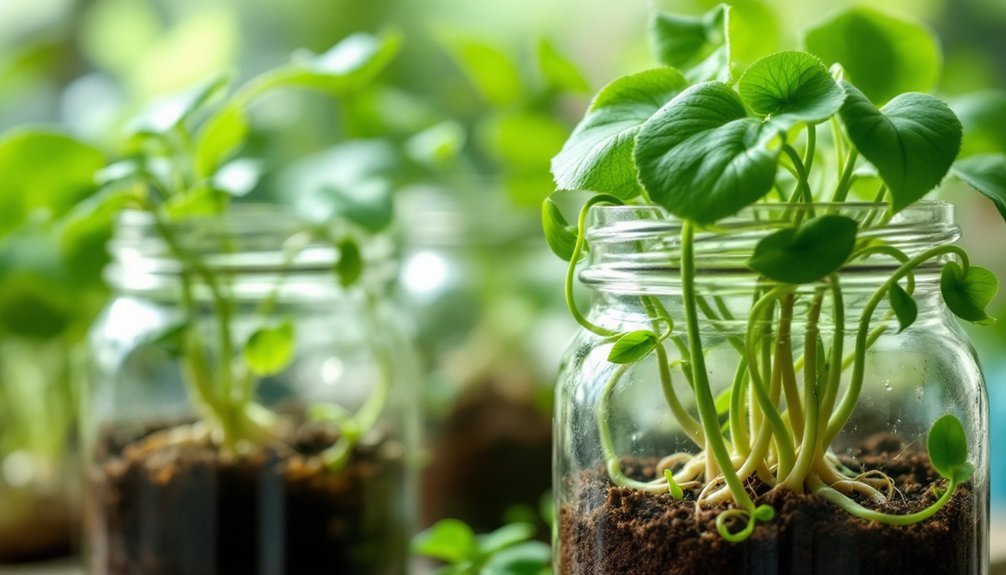Multiply your indoor vines quickly using five proven propagation methods. You'll need clean pruning shears, rooting hormone, and proper growing medium to start. Try water propagation for beginners, soil-based stem cuttings for reliable results, or air layering for larger plants. Keep your cuttings in bright indirect light with high humidity and consistent moisture. These easy techniques will transform your single vine into a thriving collection when you follow the right steps.
Essential Tools and Materials for Vine Propagation

Success in vine propagation begins with having the right tools and materials at your disposal.
You'll need clean, sharp pruning shears to make precise cuts that won't harm your mother plant. A quality rooting hormone, available in powder or gel form, will boost your chances of successful propagation by stimulating root development.
Start with sterile potting mix, either peat- or coir-based, to give your cuttings the best foundation for new growth.
To maintain essential humidity levels, you'll want to use a clear plastic propagation dome or bag over your cuttings. This creates the perfect environment for root development while protecting them from excess moisture loss.
Finally, position your cuttings where they'll receive bright indirect light, which supports photosynthesis and encourages strong, healthy growth in your new plants.
Water Propagation: The Classic Method
Water propagation stands as one of the most reliable and visually rewarding methods for growing new indoor vines. To propagate plants using this technique, you'll need stem cuttings that are 4-6 inches long with at least one node.
Before placing your cuttings in water, consider applying rooting hormone to the cut end to boost success rates.
Watch as your cuttings in water develop new roots within 1-4 weeks. You'll need to change the water weekly to prevent stagnation and guarantee your growing vines receive proper oxygen.
Once roots reach 3-5 cm in length, it's time to shift them to soil. Don't wait too long, as extended water exposure can harm root health.
Keep your propagation container in a warm, well-lit spot to speed up root development.
Soil-Based Stem Cutting Techniques

While water propagation offers a clear view of root development, soil-based stem cutting provides a direct path to establishing your indoor vines.
To start, select a healthy shoot of new growth that's 5-10 inches long and make an angled cut just below a leaf joint.
After removing the lower leaves to prevent rot, dip your stem cutting in rooting hormone. This step greatly improves your chances of successful root development.
Plant the cutting in well-draining potting mix, making sure at least one node is buried – this is where your new roots will emerge.
Water thoroughly and place the cutting in a bright location. You'll need to maintain consistent moisture throughout the rooting process, which typically takes several weeks.
Once roots establish, transfer your cutting to a larger container.
Air Layering for Climbing Vines
For indoor vine enthusiasts seeking larger propagations, air layering offers a reliable method to clone established plants while they remain connected to the parent vine.
You'll find this technique particularly effective with climbing vines like Monstera and Pothos, whose sturdy stems can handle the process.
To begin, select a healthy section of vine and remove a ring of bark where you'll encourage root growth.
Wrap this area with moist sphagnum moss and secure it with a plastic cover to maintain humidity.
The mother plant continues providing nutrients while new roots develop over 4-6 weeks.
Once you spot strong root growth through the moss, cut the section below the roots and plant it in well-draining soil.
This method's main advantage is that it produces larger plants while minimizing the stress typically associated with traditional propagation methods.
Best Growing Conditions for New Vine Cuttings

After establishing your vine cuttings through air layering or other methods, creating the right environment will determine their success.
For optimal conditions, keep temperatures between 70°F to 75°F to encourage healthy root development. Place your propagating plants in bright indirect light to protect tender new growth from scorching.
You'll need to maintain humidity levels between 60% to 80% to support new roots and prevent moisture loss. Watch your water levels carefully – keep the soil consistently damp but never waterlogged to prevent rot.
During cooler seasons, using a heat mat can provide the stable warmth your cuttings need for root growth. By maintaining these precise conditions, you'll create a prime environment where your vine cuttings can develop strong, healthy root systems.
Frequently Asked Questions
What 5 Methods Could Be Used to Propagate Plants?
You can multiply your plants through stem cuttings, leaf cuttings, layering, root division, and offsets/plantlets. Each method works best for specific plants, so choose the technique that matches your plant's characteristics.
What Is the Easiest Indoor Plant to Propagate?
You'll find the Golden Pothos is the easiest indoor plant to propagate. It grows quickly and roots readily in water or soil. You can simply cut a stem, remove lower leaves, and watch roots develop.
How Do You Propagate Indoor Vines?
You can propagate indoor vines by taking stem cuttings below a leaf node, removing lower leaves, and placing them in water or soil. Using rooting hormone will help boost success. Layering's also effective while attached.
How to Multiply Vine Plants?
You'll multiply vines by taking 5-10 inch cuttings with leaf nodes, dipping them in rooting hormone, and placing them in water or soil. Keep them warm with indirect light while roots develop.
In Summary
Ready to multiply your indoor vines? You'll find these five propagation methods work well for most climbing and trailing varieties. Choose the technique that matches your vine type and comfort level, gather your supplies, and give it a try. With proper care and patience, you'll soon have new plants to enjoy or share with fellow plant enthusiasts. Remember to maintain consistent moisture and indirect light while your cuttings develop roots.





Leave a Reply